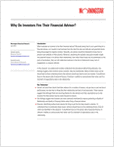Do you want to move from a traditional brokerage structure into a “revolutionary and completely out of the box” business model?
Mark J. Hanna says he did just that. A CLU and ChFC, Hanna is a benefits specialist and president of Hanna Insurance Solutions, Walnut Creek, Calif.
In a focus session here at the annual meeting of the Million Dollar Round Table, he recounted how he transitioned his business into a fee-based model that differentiates his firm from the competition.
“Are you interested in looking at an employee benefits-based business model in which you can, over time, transition your business to a fee-for-service model and build a sustainable and saleable business that isn’t subject to capricious changes in carrier compensation schedules or socialized health-care initiatives?” he asked the audience.
“(Do you want to have a model) that allows you the ability to scale up or down to serve the client segments you desire and to move away from the commodity sale that is the insurance sale?”
The model his firm has developed over the years will do that, he explained.
How so? “The answer for us was in refocusing from the products that our clients were buying to the ‘experience’ the client had in working with us,” he said.
His staff rededicated themselves to “identifying the challenges our clients were facing and the likely challenges they were about to face–and to building solutions for them before they knew they had the problem,” he added.
The focus was on delivering relevant advice.
Before discussing how his new business model evolved, he presented the audience with a related paradox:
“If you are in the benefits business, working on a commission basis, and premium rates go up, you get a raise, right? What does your client (rightfully) expect you to do? That’s right; your client wants you to work to lower his cost. In other words, you are asked to work hard to lower your income!
“Here is a paradox: What if your income wasn’t pegged to carrier commission schedules? What if carrier commission schedules were used to offset your fees?”
He urged the audience to keep the paradox in mind as it follows how the evolution of a-fee based practice might work.
Following is what happened at his own business.
In 1991, Hanna’s firm was serving about 50 client companies with an average size of about 10 employees each. It used the traditional brokerage model of service. Later, to introduce customization, it worked with carriers and ancillary providers to package a benefit design and market it to client segments.
Then, from 1995-1997, Hanna recalled, “we started to realize that our clients’ changing needs dictated that we build some human resource infrastructure around our employee benefit solutions.”
Next, in 2002, the firm began to focus on compliance around HR functions and the regulatory liability that clients faced (Sarbanes-Oxley, COBRA administration compliance, Form I-9 verification, 401(k) plan audits, etc.).








 July 06, 2008 at 04:00 PM
July 06, 2008 at 04:00 PM










